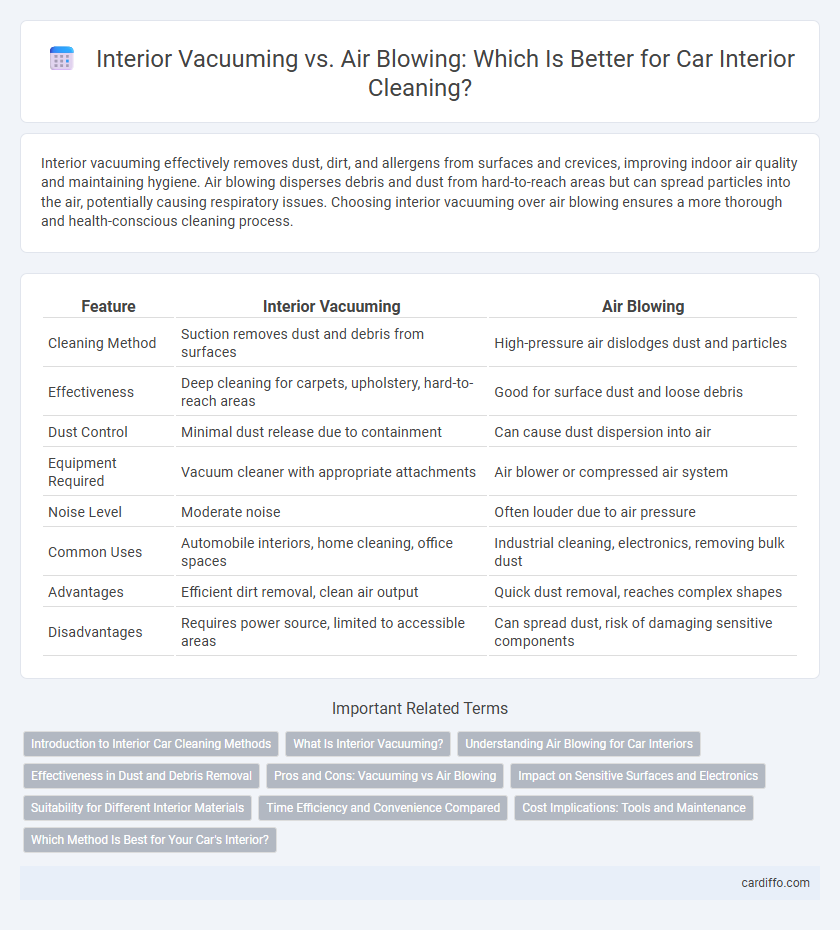Interior vacuuming effectively removes dust, dirt, and allergens from surfaces and crevices, improving indoor air quality and maintaining hygiene. Air blowing disperses debris and dust from hard-to-reach areas but can spread particles into the air, potentially causing respiratory issues. Choosing interior vacuuming over air blowing ensures a more thorough and health-conscious cleaning process.
Table of Comparison
| Feature | Interior Vacuuming | Air Blowing |
|---|---|---|
| Cleaning Method | Suction removes dust and debris from surfaces | High-pressure air dislodges dust and particles |
| Effectiveness | Deep cleaning for carpets, upholstery, hard-to-reach areas | Good for surface dust and loose debris |
| Dust Control | Minimal dust release due to containment | Can cause dust dispersion into air |
| Equipment Required | Vacuum cleaner with appropriate attachments | Air blower or compressed air system |
| Noise Level | Moderate noise | Often louder due to air pressure |
| Common Uses | Automobile interiors, home cleaning, office spaces | Industrial cleaning, electronics, removing bulk dust |
| Advantages | Efficient dirt removal, clean air output | Quick dust removal, reaches complex shapes |
| Disadvantages | Requires power source, limited to accessible areas | Can spread dust, risk of damaging sensitive components |
Introduction to Interior Car Cleaning Methods
Interior vacuuming effectively removes dust, dirt, and debris from car carpets, seats, and crevices, ensuring a deep clean without spreading particles. Air blowing uses compressed air to dislodge dust from hard-to-reach areas like vents and seams, enhancing cleanliness in tight spaces. Combining both methods optimizes interior car cleaning by targeting surface debris and embedded particles for a thorough result.
What Is Interior Vacuuming?
Interior vacuuming is a cleaning method that uses suction to remove dust, dirt, and debris from surfaces such as upholstery, carpets, and car interiors. It effectively targets hidden particles trapped in fabric fibers and crevices, improving air quality and surface hygiene. Unlike air blowing, which disperses particles, vacuuming captures contaminants for thorough removal.
Understanding Air Blowing for Car Interiors
Air blowing for car interiors uses compressed air to dislodge dust and debris from hard-to-reach areas such as vents, crevices, and under seats, making it effective for deep cleaning. This method minimizes direct contact with surfaces, reducing the risk of scratches or damage compared to traditional vacuuming. Understanding the appropriate air pressure settings and nozzle types is essential to prevent damage while maximizing cleaning efficiency in car interiors.
Effectiveness in Dust and Debris Removal
Interior vacuuming effectively captures dust and debris from carpets, upholstery, and hard-to-reach corners by using powerful suction and filters that trap particles. Air blowing dislodges dust and debris from surfaces, but often redistributes particles into the air rather than removing them completely. Vacuuming provides a more thorough and hygienic cleaning result, reducing allergens and improving indoor air quality.
Pros and Cons: Vacuuming vs Air Blowing
Vacuuming effectively removes dust, allergens, and debris from carpets, upholstery, and hard-to-reach areas, minimizing airborne particles and improving indoor air quality. Air blowing quickly dislodges dirt and dust from surfaces and hard-to-clean corners but can spread contaminants into the air, requiring further cleaning. While vacuuming offers thorough removal and better health benefits, air blowing excels in speed but may increase airborne dust levels.
Impact on Sensitive Surfaces and Electronics
Interior vacuuming offers precise debris removal without generating static or excess airflow, making it ideal for sensitive surfaces and delicate electronics prone to dust damage. Air blowing can dislodge particles from hard-to-reach areas but risks pushing dust further into vents, causing potential harm to internal components and sensitive circuitry. For electronics and fragile interiors, vacuuming minimizes static buildup and electrostatic discharge, preserving device longevity and surface integrity.
Suitability for Different Interior Materials
Interior vacuuming effectively removes dust and debris from carpet fibers, upholstery, and delicate fabrics without causing damage, making it suitable for materials like velvet, microfiber, and wool. Air blowing, while efficient for dislodging particles from hard surfaces such as wooden floors, metal fixtures, and vents, can disperse dirt into the air and may not be ideal for fragile or porous materials. Selecting the appropriate cleaning method based on the material type enhances maintenance longevity and preserves surface integrity.
Time Efficiency and Convenience Compared
Interior vacuuming offers superior time efficiency by quickly capturing dust and debris directly from surfaces, reducing the need for repeated cleaning. Air blowing disperses particles into the air, potentially prolonging cleanup time and requiring additional measures to manage settled dust. Vacuuming enhances convenience through integrated suction and filtration, minimizing airborne allergens and residues in enclosed spaces.
Cost Implications: Tools and Maintenance
Interior vacuuming requires investment in vacuum cleaners, filters, and regular maintenance such as bag replacement and motor servicing, which can incur moderate ongoing costs. Air blowing tools, like compressors and blowers, often have higher upfront expenses and demand frequent filter changes and lubrication to maintain efficiency, potentially increasing long-term maintenance costs. Choosing between these methods depends on budget constraints and the anticipated frequency of use, with vacuuming generally offering a more cost-effective solution for regular interior cleaning.
Which Method Is Best for Your Car's Interior?
Interior vacuuming removes dust, dirt, and debris from car seats, carpets, and crevices effectively, ensuring deep cleaning without scattering particles. Air blowing uses high-pressure air to dislodge dirt from hard-to-reach areas but may spread dust around if not followed by vacuuming. For a comprehensive clean, combining vacuuming with air blowing delivers the best results for maintaining your car's interior hygiene.
Interior vacuuming vs Air blowing Infographic

 cardiffo.com
cardiffo.com